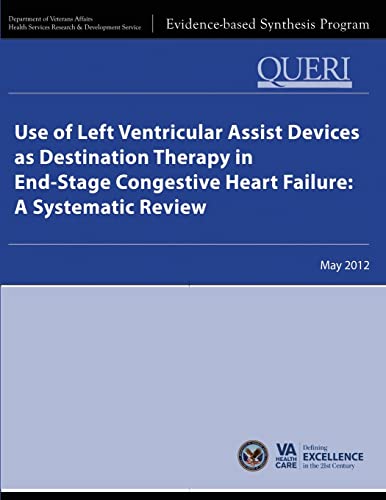Use of Left Ventricular Assist Devices as Destination Therapy in End-Stage Congestive Heart Failure: A Systematic Review - Softcover

Zu dieser ISBN ist aktuell kein Angebot verfügbar.
Alle Exemplare der Ausgabe mit dieser ISBN anzeigen:
Reseña del editor:
Several common chronic conditions such as atherosclerotic heart disease and hypertension as well as other diseases can result in heart failure, a reduced ability of the heart to pump blood and maintain normal bodily functions. More than 100,000 people in the U.S. with progressive heart failure are refractory to available treatments and have high rates of hospitalization and mortality and a poor quality of life due to limited physical and social activities and psychological stress. Heart transplantation is currently the preferred treatment for end-stage heart failure. Unfortunately, the supply of donor hearts is far less than needed and many patients do not meet the criteria for heart transplantation primarily due to old age and comorbidities such as diabetes with damage to vital organs, pulmonary hypertension, renal insufficiency, malignancies and morbid obesity. Implantable mechanical pumps that assist the circulation of blood by one or both ventricles of the heart have evolved over several decades. Typically blood flows from the native left ventricle of the heart into the surgically implanted assist device and is pumped out into the aorta via an implanted conduit. Currently, long-term implantable left ventricular assist devices require an external source of power and control module. Surgical placement of a left ventricular assist device is increasingly done as a last resort for patients with refractory heart failure who are not eligible for heart transplantation, so called destination therapy. Some patients may improve after they receive a ventricular assist device as destination therapy and become eligible for heart transplantation even though this was not the initial therapeutic goal. A limited number may recover enough heart function to not need a heart transplant or mechanical assist device. Although survival with a newer generation continuous flow ventricular assist device is approaching that of a heart transplant, long-term use of the device by patients who are eligible for a heart transplant is not currently accepted practice. Conversely, many patients that receive a ventricular assist device as a bridge to transplant use the device for increasingly prolonged periods while waiting for a donated heart and some may become ineligible for a heart transplant. The purpose of this report is to review the scientific evidence for use of ventricular assist devices as destination therapy for patients with severe, refractory heart failure who are not eligible for heart transplantation at the time the device is implanted. Although many patients receive the same types of ventricular assist devices as a bridge to heart transplantation or recovery, the characteristics, hence risk profiles, of patients receiving bridge therapy are different from patients selected to receive a device as permanent destination therapy. Furthermore many bridged patients do receive a heart transplant that alters patient outcomes. This review focused on evidence about patient outcomes, patient selection and cost effectiveness of ventricular assist devices specifically intended as destination therapy. The primary goals of destination therapy are to: prolong survival, improve daily function and health-related quality of life, minimize harms including infection, major bleeding episodes, thromboembolic events including strokes and device malfunction or failure especially those that require hospital care. The key questions were: #1. How does use of an FDA-approved, current generation LVAD as destination therapy (i.e., the HeartMate II left ventricular assist device) effect patient outcomes? #2. What patient or site characteristics have been associated with patient benefits or harms when the FDA-approved, current generation LVAD is used as destination therapy? #3. What is the range of cost-effectiveness estimates of using the FDA-approved, current generation LVAD as destination therapy in end-stage heart failure and what explains variation in these estimates?
„Über diesen Titel“ kann sich auf eine andere Ausgabe dieses Titels beziehen.
- VerlagCreateSpace Independent Publishing Platform
- Erscheinungsdatum2013
- ISBN 10 1489539751
- ISBN 13 9781489539755
- EinbandTapa blanda
- Anzahl der Seiten48
Neu kaufen
Mehr zu diesem Angebot erfahren
EUR 20,64
Versand:
EUR 10,48
Von Vereinigtes Königreich nach USA
Beste Suchergebnisse bei AbeBooks
Use of Left Ventricular Assist Devices as Destination Therapy in End-Stage Congestive Heart Failure: A Systematic Review
Verlag:
Createspace Independent Publishing Platform
(2013)
ISBN 10: 1489539751
ISBN 13: 9781489539755
Neu
Paperback / softback
Anzahl: > 20
Anbieter:
Bewertung
Buchbeschreibung Paperback / softback. Zustand: New. This item is printed on demand. New copy - Usually dispatched within 5-9 working days. Bestandsnummer des Verkäufers C9781489539755
Weitere Informationen zu diesem Verkäufer | Verkäufer kontaktieren
Neu kaufen
EUR 20,64
Währung umrechnen

